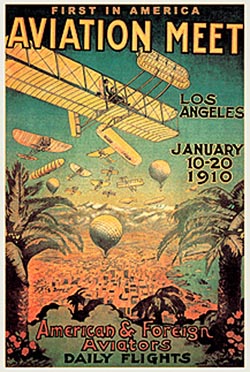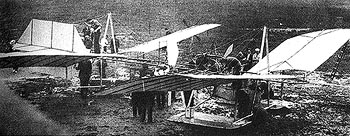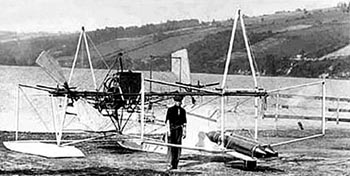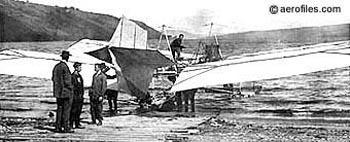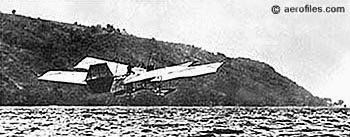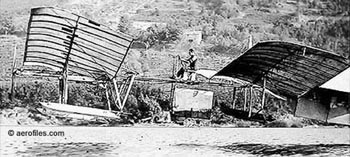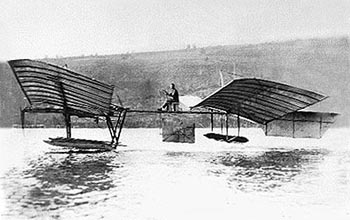
Glenn Hammond Curtiss, (1878 - 1930)
Glenn H. Curtiss was born May 21, 1878, at Hammondsport, New York. Educated in public schools his youth was dominated by a curiosity of things mechanical. While still in his teens he developed a successful bicycle business and later turned to motorcycles. By 1905 he became renowned for his motorbikes and racing feats throughout the country. Interest in aeronautics came in July 1904, when the famed balloonist Thomas Baldwin requested a Curtiss engine for his dirigible, the "California Arrow".
The organization had as its primary purpose a serious and scientific study of winged flight. Members designed and built various "aerodromes" but on May 22, 1908, when Glenn successfully flew his "White Wing" a distance of 1,017 feet, additional fame was added to his achievements and the new field of aeronautics beckoned to him. The findings of the A.E.A. projects led to the Curtiss "June Bug" which was entered in competition for the Scientific American Trophy. In it, on July 4, 1908, Curtiss won the trophy by flying well over the one-kilometer flight required to win. On July 17, 1909, in the "Gold Bug", the second leg of the Scientific American Trophy was won and his flight with the "Albany Flyer" won the third leg on May 31, 1910. These flights were for longest distance, circular flight and cross-country flight and won him permanent possession of the Trophy. In August 1909, he won the Gordon Bennett Cup for speed at Rheims, France, scorching the air at 46 mph. For his great accomplishments in aviation, his willingness to help to share his findings and public demonstration all his flights, the Aero Club of America awarded him aviator License Number One on June 8, 1911. In the same year he developed the first successful hydro airplane and in 1912 the flying boat. Glenn Curtiss was awarded the Gold Medal of the Aero Club of America in December 1911, and again in December 1912. For flying boat development, he received the Langley Medal in 1913. His aircraft were becoming world famous, his name almost legendary.
A Glenn H. Curtiss Illustrated Timeline c.1906 - 1919
Draft #1 [Feb 2002], and assembled, except where noted, from the following websites and or texts...
aeroweb.brooklyn.cuny.edu, www.cbnet.ns.ca, www.skytamer.com, www.playbill.on.ca and users.commkey.net
Selected international events are shown in Blue
Oct. 23, 1906
Oct. 01, 1907 image
1907-09: A design consortium ..,gathered by Alexander Graham Bell at his Canadian home; an early "think tank," advancing the experiments of Australian Lawrence Hargrave during the 1890s. Aircraft were built at Hammondsport NY. [http://aerofiles.com/_ab.html]Nov. 30, 1907 Glenn Curtiss founds the Curtiss Aeroplane Company. This is the first airplane manufacturer in the U.S.
Dec. 06, 1907
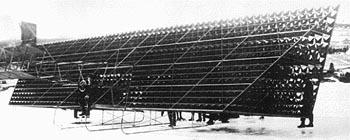 Bell, Cygnet 1, 1907 download a 750pixel image
Aerodrome #5, Cygnet 1909 = Odd "flying wall" on skids with a huge frontal surface composed of 360 tetrahedral cells - a concept carried forward from Bell's 1902 kite designs - arranged in a rectangular wingform, and with the pilot perched well out in front on skids; span: 40'0" (>52'6") length: 13'1". Tested at Baddeck, Nova Scotia, on 2/22 and 24/1909, but failed to fly. Alexander G Bell. Developed from 1907 kite-glider Cygnet I, which was towed by a motorboat to an altitude of 168' (p: T Selfridge), but was destroyed in landing on the water. As Cygnet II, it was modified with tricycle gear, 26'4" span, and an 8-cylinder Curtiss motor, with no success. It did finally fly, as Cygnet III, with 70hp Gnôme rotary to help overcome its frontal mass, from ice-covered Lake Bras d'Or, Nova Scotia, on 3/1/12, attaining 43mph (p: J McCurdy). [http://aerofiles.com/_ab.html]Mar. 12, 1908 The first public flight of a powered heavier than air machine in the United States. (Hammondsport, N.Y.) The Red Wing, first of four biplanes built by the A.E.A. was designed by Lt. Thomas Selfridge. It was powered by a 40 hp Curtiss engine and acquired its name from the red silk used to make the wings. It flew 97 meters above the ice on Lake Keuka. image
Aerodrome #1, Red Wing 1908 = 1pOBF(skids); 40hp* Curtiss air-cooled V-8 pusher; span: 43'4" length: 26'3" load: 185#. Thomas Selfridge. Named for its red fabric coloring, covered thusly for the sake of documenting photography. First public flight of an airplane in the US. Having no lateral control, it crashed on its first flight at Lake Keuka NY on 3/12/08 after flying a distance of 318'11" (p: F W Baldwin). *Actual flight efficiency was estimated to be less than 20hp. [http://aerofiles.com/_ab.html]image The 'Red Wing', with pilot "Casey" Baldwin before its flight. Lake Keuka, New York, on March 12, 1908
May 18, 1908 image
Aerodrome #2, White Wing 1908 = 1pOB; 40hp Curtiss air-cooled V-8 pusher; span: 42'3" length: 26'3" load: 175#. F W Baldwin; ff: 5/18/08 (p: Baldwin). Tricycle gear; first use of ailerons (which led to long-term litigation over the Wright Brothers' claim of violation of their patent for movable wing surfaces). Lateral control of movable, triangular ailerons was by way of a body yoke attached to the pilot, who leaned in the direction of a turn. Flew a distance of 1,017' on 5/21/08 (p: Glenn Curtiss). Damaged beyond repair on landing two days later, and abandoned. [http://aerofiles.com/_ab.html]May 23, 1908 John A.D. McCurdy flies for the first time. Unfortunately for The White Wing, McCurdy's first flight ends in a crash in which McCurdy is only slightly injured.
Jun. 21, 1908 image
Aerodrome #3, June Bug 1908 = 1pOB; 40-50hp Curtiss air-cooled V-8 pusher; span: 42'6" length: 27'6" load: 142# v: 39/x/x. Glenn Curtiss. Employed pilot-induced movable wing-tips as ailerons, as on White Wing; ff: 5/21/08 (p: Curtiss) for a distance of 152 yds. Made a total of 32 flights until Aug 31, one of which marked the first plane to fly one kilometer, on 7/4/08, at a recorded 39mph, for which Curtiss was awarded the Scientific American trophy. Design evolved into 1909 Curtiss Golden Flyer. [http://aerofiles.com/_ab.html]Jul. 04, 1908 Glenn Curtiss wins the $2,500 silver trophy offered by the Scientific American journal for an official flight over one kilometer. Curtiss flew the AEA's June Bug 1.1 miles, nearly twice the required distance, at the Stony Brook Farm race-track, the AEA base.
Jul. 10, 1908
Jul. 13, 1908 image
Jul. 20, 1908
Aug. 29, 1908
Sep. 17, 1908 image
Oct. 16, 1908 image
Dec. 06, 1908 image
Aerodrome #4, Silver Dart 1908 = 1pOB; 35-50hp Curtiss water-cooled V-8 pusher; span: 49'1" length: 30'0" load: 290#* v (est): 40/x/x. John McCurdy; ff: 12/6/08 (p: McCurdy). *Calculated useful load showed figures of 150# for pilot, 110# of gas and oil (including tank), and 30# of water. Made from steel tube, bamboo, friction tape, wire and wood, it was covered with rubberized silk balloon-cloth, its propeller was carved from a solid block of wood, and it had no brakes. The last of AEA's team efforts, it went to Canada and became the first airplane to fly in that country, on 2/23/09 (p: McCurdy). Although the Canadian Army was unimpressed and felt that airplanes would never amount to much in actual warfare, AEA was finally invited to the base at Petawawa to show their machine. Sandy terrain there was problem for the aircraft's small wheels - there was great difficulty taking off. Then, on the fifth flight, McCurdy wrecked the craft on landing when one wheel struck a rise in the ground, and thus ended the career of the Silver Dart. [http://aerofiles.com/_ab.html]Feb. 23, 1909 John A.D. McCurdy flies his Silver Dart over the frozen Bras d'Or Lakes at Baddeck, N.S. The first powered and controlled flight in the British Empire.
Mar. 02, 1909 image
1 (aka Golden Flier) 1909 = 1pOB; 25-30hp 4-cyl Curtiss water-cooled pusher; span: 28'9" length: 30'4" (>30'6") v: 45/x/x. Glenn Curtiss, developed from AEA June Bug; aka Aeronautic Society of New York Model D Golden Flier, since the first one was contracted for by that Society. Although often referred to as Herring-Curtiss, it was actually built after the partners' dissolution. Erroneously called "Gold Bug" from newsmen's contamination of names, it was flown in exhibitions by Curtiss and Charles F Willard. POP: 9, included winning 1909 Rheims Racer and 1910 Banshee Express (p: Charles Willard) with 50hp Willard-Curtiss pusher. Herring's contribution, besides that as a temporary partner, was his alleged invention of a gyroscopic stabilization device (claimed, but unsubstantiated, 1909 US patent #12,256), which would circumvent the Wright's aileron patents, but which was never used on any Curtiss machine. [http://aerofiles.com/_curt.html]Mar. 20, 1909 Glenn Curtiss and Augustus Herring form the Herring-Curtiss Company, starting with $360,000.
Mar. 31, 1909
Apr. 1909
Aug. 2, 1909
Aug. 11 1909 image
Aug. 22 - 29, 1909
 Gordon Bennett Trophy
2, Rheims (Reims) Racer (aka Herring-Curtiss Model D) 1909 = 1pOB; 63hp Curtiss V8; span: 34'0" length: 30'4". A larger, re-engined version of Curtiss' first effort, used for competition in the 1909 Gordon Bennett Cup Race at Rheims (now: Reims), France, where Curtiss set a speed record (47.06 mph), as well as winning events at Brescia, Italy, and for subsequent exhibition flights in the US. Also set a speed record of 55 mph at first US air meet, 1/10-20/10, at Dominguez Hills in Los Angeles, attended by an estimated crowd of 30,000. Sold to Charles K Hamilton, who flew exhibitions in it until he crashed at Seattle on 3/12/10. [http://aerofiles.com/_curt.html]Sep. 1909 The CAC workers complete structural work on the Baddeck No. 2 and move the factory from Beinn Bhreagh to a meadow on the Baddeck River(Bentick Farm).
Sep. 30, 1909 image
Oct. 07, 1909
image
Jan. 10 - 20, 1910
Aviation Meet, Los Angeles, Jan. 10 - 20, 1910
Mar. 28, 1910
image
Apr. 13, 1910
Apr. 1910
image
May 29, 1910
image : hudson_flyer_large.jpg
http://glenncurtiss.com/hudson_flyer.htm
The radiator for the liquid cooled V8 engine can be seen behind the pilot's head. The tubular gasoline tank is above his head under the top wing. Pushing and pulling the wheel operates the front elevators. Turning the wheel operates the rear rudder. Leaning from side to side operates the yoke around the pilots shoulders to control the ailerons which are between the wings and attached to the two outboard front inter-wing struts.
This picture was made at Hammondsport, NY, the site of Curtiss' motorcycle factory.
Jun. 17 1910
Jun. 30, 1910
Aug. 27, 1910
Oct. 5, 1910
Nov. 14, 1910
image
Jan. 18, 1911
Jan. 30, 1911
Feb 01, 1911
Feb 17, 1911
Apr. 11, 1911
image
May 8, 1911
image : 026128-25_curtiss_A-1.jpg
Jul. 01, 1911
image
Jan. 10, 1912
image
Mar. 9-17 1912
Nov. 27, 1912
May 28, 1914
image
Sep. 12, 1916
image
May 8 - 31, 1919
image
Glenn Curtiss and Samuel Langley
On May 28, 1914, the 'Langley Aerodrome' is flown successfully by Glenn Curtiss, who has rebuilt and greatly modified the aircraft for Mr. Walcott, the secretary of the Smithsonian Institution. Curtiss and Mr. Walcott, the secretary of the Smithsonian Institution, are determined to prove that a machine could have flown before the Wrights' first flight, thereby invalidate their commercially valuable patents.
and from http://www.150.si.edu, ...
The fourth Secretary (a largely self-taught geologist and paleontologist named Charles D. Walcott) staunchly defended his predecessor's aeronautical experiments. In 1914, to determine whether it had been capable of sustained flight, he agreed to a reconstruction of Langley's 1903 Aerodrome by the aeronautical pioneer Glenn Hammond Curtiss.
During tests, however, Curtiss made considerable alterations. In what was one of Walcott's few lapses in judgment, when the experiments proved successful the Smithsonian published a statement describing the Aerodrome as "the first aircraft in history capable of flight with a pilot and several hundred pounds of useful load."
When the "restored" Aerodrome was put on exhibit in the National Museum in 1918, the label identified it as "The Original, Full-size Langley Flying Machine, 1903." Another label-"The first man-carrying aeroplane in the history of the world capable of sustained free flight"-was soon substituted, and later modified with the qualification: "in the opinion of many competent to judge."
These claims prolonged an ongoing patent controversy over the Wright brothers' flight designs, and seemed to align the Smithsonian with those challenging the Wrights both for the honor of being first in flight and the money deriving from that honor.
They briefly cast the Smithsonian's probity in doubt, and soured relations between the institution and Orville Wright, one of America's greatest heroes, at a time when war again aroused interest in airplanes as strategic weapons. Meanwhile, Wright sent the Flyer to London's Science Museum, where many feared it would remain.
Curtiss-Langley 'Aerodome' Gallery
The Curtiss-Langley Aerodome Flight, May 28, 1914
Download a 750pixel image
The Curtiss-Langley Aerodome Flight, May 28, 1914
The Curtiss-Langley Aerodome Flight, May 28, 1914
The Curtiss-Langley Aerodome Flight, May 28, 1914
The Curtiss-Langley Aerodome Flight, May 28, 1914
The Curtiss-Langley Aerodome Flight, May 28, 1914
Over and on the Sea : The Pioneers of the Seaplane
which in part says...
One of the next major advancements in human flight came in response to a contest sponsored by The Daily Mail of London, which offered a prize to the first aviator to fly across the English Channel. Louis Blériot (1872-1936) won the contest, flying from Calais, France, to Dover, England, on July 25, 1909, in a monoplane of his own design with a 25-horsepower engine. His flight caused concern among the British that the airplane could eventually be used for military aggression, and the world came to see the airplane as a future weapon.
The pioneers of the seaplane were Henri Fabre (1882-1984) and Glenn H. Curtiss (1878-1930). Fabre is generally credited with making the first seaplane flight, on March 28, 1910, at Martigues, France. His seaplane, or hydravion, had a 50-horsepower Gnome rotary engine and was mounted on lightweight hollow wooden floats. The apparatus flew only short distances, however, and just two months later it was wrecked when it took a sudden nosedive into the Mediterranean.
The first practical seaplane was constructed and flown by Curtiss in 1911, and in 1919 one of Curtiss's "flying boats" made the first transatlantic crossing (with stops). He became one of the most successful American aircraft builders in the decades following the invention of the airplane.
Glenn Hammond Curtiss and Alexander Graham Bell
which in part says...
After 1895 Bell's interest turned mostly to aeronautics. Many of his inventions in this area were first tested near his summer home at Baddeck on Cape Breton Island in Nova Scotia, Canada. His study of flight began with the construction of large kites, and in 1907 he devised a kite capable of carrying a person.
With a group of associates, including the American inventor and aviator Glenn Hammond Curtiss, Bell developed the aileron, a movable section of an airplane wing that controls roll. They also developed the tricycle landing gear, which first permitted takeoff and landing on a flying field.
Applying the principles of aeronautics to marine propulsion, his group started work on hydrofoil boats, which travel above the water at high speeds. His final full-sized "hydrodrome," developed in 1917, reached speeds in excess of 113 km/h (70 mph) and for many years was the fastest boat in the world.
The Aerial Experiment Association
which in part says...
Glenn Curtiss and Alexander Graham Bell had first met in New York in 1905, at which time Bell invited Curtiss to visit him at his summer home, Beinn Bhreagh (Gaelic for "Lovely Mountain"), near Baddeck on Cape Breton Island, Nova Scotia. In that cool, remote retreat among the rocks and pines, Bell had been conducting a series of experiments with tetrahedral kites---four-sided, lightweight aluminum frames covered with silk---one of which, a large and relatively strong model, possessed great inherent stability.
Bell was anxious to attach one of the Curtiss motors to it as part of his studies in aerodynamic lift, propulsion, and control, for he had set his sights on the contstruction of a machine that would fly even before the Wrights had taken off at Kitty Hawk. In January 1903, for example, Bell was quoted by the Boston Transcript as hypothesizing that "an aeroplane kite could carry the weiight of a motor and a man." Realization of this exploit would be only one step short of the goal of free flight.
Bell had gathered around him at Baddeck a group of bright young men, including two recent graduates in mechanical engineering of the University of Toronto: Frederick Walker ("Casey") Baldwin (no relation to the balloonist) and John A. D. McCurdy, son of an inventor, who was to mature into one of America's foremost aviators.
Villard, Henry Serrano, Contact, The Story of the Early Birds
Aerial Experiment Association
A Most Noble Experiment
Bell's Boys
A.E.A. Silver Dart
and for more on members of the AEA, see...
Dr Alexander Graham Bell (1847 - 1922)
The Bell Family Collection
Lt. Thomas Etholen Selfridge (1882 - 1908)
Lt. Thomas E. Selfridge
National Aviation Hall of Fame
John Alexander Douglas McCurdy (1886-1961)
Great Aviators : John Alexander Douglas McCurdy
John A.D. McCurdy 1886-1961
Glenn H. Curtiss (1878 - 1930)
Aerofiles : Glenn Curtiss
Glenn H. Curtiss : The Henry Ford of Aviation
Vintage Views of New York : Glenn Curtiss
curtiss wright.com
including...
Glenn Hammond Curtiss - To Get into the Air
June Bug
Glen Curtiss : 1909
Wing Warping, Ailerons, and Litigation
The Hudson River Flight
Curtis and the Flying Boat
Glenn Curtiss : Father of Naval Aviation
Search San Diego Historical Society for: Glenn Curtiss
Glenn Curtiss, San Diego aviation pioneer
Stineman photographs : San Diego : Glenn Curtiss
|
© Copyright 1999-2002 CTIE - All Rights Reserved - Caution |
 Glenn Hammond Curtiss
Glenn Hammond Curtiss